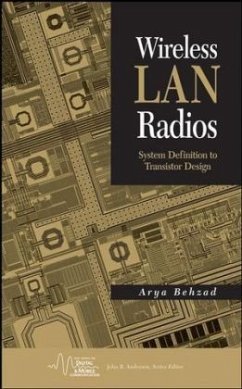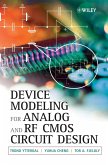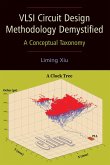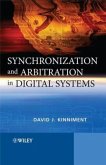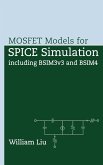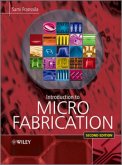- Gebundenes Buch
- Merkliste
- Auf die Merkliste
- Bewerten Bewerten
- Teilen
- Produkt teilen
- Produkterinnerung
- Produkterinnerung
Wireless LAN Radios presents a sophisticated overview of the subject, covering theory while also emphasizing the practical aspects of this promising technology. Coverage includes 802.11 flavors and system requirements; receiver and transmitter radio architectures; analog impairments and issues; key radio building blocks; calibration techniques; case studies; and a brief discussion of 802.11n. It offers a meaningful presentation of real-world issues facing designers, engineers, theorists, and researchers working in this industry.
Andere Kunden interessierten sich auch für
![Phase Lock Loops and Frequency Synthesis Phase Lock Loops and Frequency Synthesis]() Vinceslav F. KroupaPhase Lock Loops and Frequency Synthesis195,99 €
Vinceslav F. KroupaPhase Lock Loops and Frequency Synthesis195,99 €![Asynchronous Circuit Design Asynchronous Circuit Design]() Chris J. MyersAsynchronous Circuit Design185,99 €
Chris J. MyersAsynchronous Circuit Design185,99 €![Device Modeling for Analog and RF CMOS Circuit Design Device Modeling for Analog and RF CMOS Circuit Design]() Trond YtterdalDevice Modeling for Analog and RF CMOS Circuit Design191,99 €
Trond YtterdalDevice Modeling for Analog and RF CMOS Circuit Design191,99 €![VLSI Circuit Design Methodology VLSI Circuit Design Methodology]() Liming XiuVLSI Circuit Design Methodology113,99 €
Liming XiuVLSI Circuit Design Methodology113,99 €![Synchronization and Arbitration in Digital Systems Synchronization and Arbitration in Digital Systems]() David J. KinnimentSynchronization and Arbitration in Digital Systems135,99 €
David J. KinnimentSynchronization and Arbitration in Digital Systems135,99 €![Mosfet Models for Spice Simulation Mosfet Models for Spice Simulation]() William LiuMosfet Models for Spice Simulation232,99 €
William LiuMosfet Models for Spice Simulation232,99 €![Introduction to Microfabrication Introduction to Microfabrication]() Sami FranssilaIntroduction to Microfabrication95,99 €
Sami FranssilaIntroduction to Microfabrication95,99 €-
-
-
Wireless LAN Radios presents a sophisticated overview of the subject, covering theory while also emphasizing the practical aspects of this promising technology. Coverage includes 802.11 flavors and system requirements; receiver and transmitter radio architectures; analog impairments and issues; key radio building blocks; calibration techniques; case studies; and a brief discussion of 802.11n. It offers a meaningful presentation of real-world issues facing designers, engineers, theorists, and researchers working in this industry.
Hinweis: Dieser Artikel kann nur an eine deutsche Lieferadresse ausgeliefert werden.
Hinweis: Dieser Artikel kann nur an eine deutsche Lieferadresse ausgeliefert werden.
Produktdetails
- Produktdetails
- IEEE Series on Digital & Mobile Communication
- Verlag: Wiley & Sons
- Artikelnr. des Verlages: 14670964000
- 1. Auflage
- Seitenzahl: 256
- Erscheinungstermin: 17. Dezember 2007
- Englisch
- Abmessung: 236mm x 155mm x 20mm
- Gewicht: 560g
- ISBN-13: 9780471709640
- ISBN-10: 0471709646
- Artikelnr.: 23169494
- Herstellerkennzeichnung
- Libri GmbH
- Europaallee 1
- 36244 Bad Hersfeld
- gpsr@libri.de
- IEEE Series on Digital & Mobile Communication
- Verlag: Wiley & Sons
- Artikelnr. des Verlages: 14670964000
- 1. Auflage
- Seitenzahl: 256
- Erscheinungstermin: 17. Dezember 2007
- Englisch
- Abmessung: 236mm x 155mm x 20mm
- Gewicht: 560g
- ISBN-13: 9780471709640
- ISBN-10: 0471709646
- Artikelnr.: 23169494
- Herstellerkennzeichnung
- Libri GmbH
- Europaallee 1
- 36244 Bad Hersfeld
- gpsr@libri.de
Arya Behzad is currently a Broadcom Distinguished Engineer, where he is the Director of Engineering working on radios for current and future generation wireless products and Product Line Manager for all wireless LAN radio products. This book and his IEEE Expert Now course on wireless LAN radio design are both derived from his popular course on this topic at the IEEE ISSCC.
Preface ix
Acronyms xi
CHAPTER 1 802.11 Flavors and System Requirements 1
1.1 Definition 1
1.2 WLAN Market Trends 3
1.3 History of 802.11 6
1.4 802.11: b, a, or g? 8
1.5 802.11b Standard 10
1.6 802.11a Channel Allocation 13
1.7 802.11a and 802.11g: OFDM Mapping 14
1.7.1 Multipath Fading 14
1.8 802.11a/g: Data Rates 21
1.9 802.11a/g OFDM Packet Construction 24
1.10 802.11 System Requirements 24
1.10.1 Receiver Sensitivity 24
1.10.2 Transmitter Error Vector Magnitude 26
1.10.3 Transmitter Spectral Mask 28
1.11 Vector Signal Analysis 33
CHAPTER 2 Radio Receiver and Transmitter Architectures 43
2.1 Architectures 43
2.1.1 Superheterodyne Receiver 44
2.1.1.1 Choice of Intermediate Frequency in Superheterodyne Receiver 47
2.1.2 Low IF Receiver 51
2.1.3 Direct-Conversion Receiver 55
2.1.4 Receiver Architectures: Summary 59
2.1.5 Superheterodyne Transmitter 60
2.1.6 Low IF Transmitter 64
2.1.7 Direct-Conversion Transmitter 64
2.1.8 Polar Modulators 66
2.2 Process Choices: CMOS versus SiGe BiCMOS 67
CHAPTER 3 Analog Impairments and Issues 73
3.1 Receiver Sensitivity and Noise Figure 73
3.2 Receiver DC Offsets and LO Leakage 75
3.3 Receiver Flicker Noise 79
3.4 Receiver Interferers and Intermodulation Distortion 83
3.4.1 IP3, IP2, and P1dB 83
3.4.2 Tools for Analyzing Modulated Signal Distortion 96
3.5 Receiver Image Rejection 102
3.5.1 Superheterodyne Receiver 102
3.5.2 Low IF Architecture 104
3.5.3 Direct-Conversion Receiver 106
3.6 Quadrature Balance and Relation to Image Rejection 107
3.7 Quadrature Balance and Relation to EVM 109
3.8 Other Transmitter (Modulator) Impairments 116
3.9 Peak-to-Average Ratio and Relation to Linearity and Efficiency 121
3.10 Local Oscillator Pulling in PLL 124
3.11 Phase Noise in PLL 126
3.12 Far-Out Phase Noise 130
3.13 Effect of Phase Noise on OFDM Systems 131
3.14 Effect of Frequency Errors on OFDM 132
3.15 Summary of Analog/RF Impairments 135
CHAPTER 4 Some Key Radio Building Blocks 137
4.1 Low Noise Amplifier 137
4.2 Mixer and its Local Oscillator Buffers 142
4.3 Power Amplifier 148
4.4 Fully Integrated VCO 153
4.5 Multifrequency (Stacked) Mixer 157
4.6 Open-Loop Transconductance Linearization Circuit 158
CHAPTER 5 Calibration Techniques 161
5.1 VCO Calibration 163
5.2 Automatic Frequency Control 165
5.3 Quadrature Error and Local Oscillator Feedthrough Calibration 172
5.4 Bias Current Calibrations (R Calibration) 175
5.5 Filter Time-Constant Calibration (RC Calibration) 176
5.6 Other Calibrations 177
CHAPTER 6 Case Studies 179
6.1 Case Study 1: A CMOS 802.11a Transceiver 179
6.1.1 Architecture and Circuit Implementation 179
6.1.2 Receiver 181
6.1.3 Transmitter 183
6.1.4 Phase-Locked Loop 186
6.2 Case Study 2: High Performance WLAN Transmitter Utilizing Quadrature
and LOFT Calibration 189
CHAPTER 7 Brief Discussion Of 802.11n and Concluding Remarks 197
7.1 Need for 802.11n 197
7.2 802.11a/b/g/n MIMO Transceiver 202
7.2.1 Architecture and Circuit Implementation 203
7.2.1.1 Receiver 203
7.2.1.2 Transmitter 205
7.2.1.3 PLL and LO Generation 207
7.2.1.4 Calibration Techniques 209
7.2.2 Packaging Issues 211
7.2.3 Measurement Results 211
7.2.4 MIMO Case Study Conclusion 216
7.3 Concluding Remarks 217
References 221
Annotated Bibliography 223
Index 233
About the Author 241
Acronyms xi
CHAPTER 1 802.11 Flavors and System Requirements 1
1.1 Definition 1
1.2 WLAN Market Trends 3
1.3 History of 802.11 6
1.4 802.11: b, a, or g? 8
1.5 802.11b Standard 10
1.6 802.11a Channel Allocation 13
1.7 802.11a and 802.11g: OFDM Mapping 14
1.7.1 Multipath Fading 14
1.8 802.11a/g: Data Rates 21
1.9 802.11a/g OFDM Packet Construction 24
1.10 802.11 System Requirements 24
1.10.1 Receiver Sensitivity 24
1.10.2 Transmitter Error Vector Magnitude 26
1.10.3 Transmitter Spectral Mask 28
1.11 Vector Signal Analysis 33
CHAPTER 2 Radio Receiver and Transmitter Architectures 43
2.1 Architectures 43
2.1.1 Superheterodyne Receiver 44
2.1.1.1 Choice of Intermediate Frequency in Superheterodyne Receiver 47
2.1.2 Low IF Receiver 51
2.1.3 Direct-Conversion Receiver 55
2.1.4 Receiver Architectures: Summary 59
2.1.5 Superheterodyne Transmitter 60
2.1.6 Low IF Transmitter 64
2.1.7 Direct-Conversion Transmitter 64
2.1.8 Polar Modulators 66
2.2 Process Choices: CMOS versus SiGe BiCMOS 67
CHAPTER 3 Analog Impairments and Issues 73
3.1 Receiver Sensitivity and Noise Figure 73
3.2 Receiver DC Offsets and LO Leakage 75
3.3 Receiver Flicker Noise 79
3.4 Receiver Interferers and Intermodulation Distortion 83
3.4.1 IP3, IP2, and P1dB 83
3.4.2 Tools for Analyzing Modulated Signal Distortion 96
3.5 Receiver Image Rejection 102
3.5.1 Superheterodyne Receiver 102
3.5.2 Low IF Architecture 104
3.5.3 Direct-Conversion Receiver 106
3.6 Quadrature Balance and Relation to Image Rejection 107
3.7 Quadrature Balance and Relation to EVM 109
3.8 Other Transmitter (Modulator) Impairments 116
3.9 Peak-to-Average Ratio and Relation to Linearity and Efficiency 121
3.10 Local Oscillator Pulling in PLL 124
3.11 Phase Noise in PLL 126
3.12 Far-Out Phase Noise 130
3.13 Effect of Phase Noise on OFDM Systems 131
3.14 Effect of Frequency Errors on OFDM 132
3.15 Summary of Analog/RF Impairments 135
CHAPTER 4 Some Key Radio Building Blocks 137
4.1 Low Noise Amplifier 137
4.2 Mixer and its Local Oscillator Buffers 142
4.3 Power Amplifier 148
4.4 Fully Integrated VCO 153
4.5 Multifrequency (Stacked) Mixer 157
4.6 Open-Loop Transconductance Linearization Circuit 158
CHAPTER 5 Calibration Techniques 161
5.1 VCO Calibration 163
5.2 Automatic Frequency Control 165
5.3 Quadrature Error and Local Oscillator Feedthrough Calibration 172
5.4 Bias Current Calibrations (R Calibration) 175
5.5 Filter Time-Constant Calibration (RC Calibration) 176
5.6 Other Calibrations 177
CHAPTER 6 Case Studies 179
6.1 Case Study 1: A CMOS 802.11a Transceiver 179
6.1.1 Architecture and Circuit Implementation 179
6.1.2 Receiver 181
6.1.3 Transmitter 183
6.1.4 Phase-Locked Loop 186
6.2 Case Study 2: High Performance WLAN Transmitter Utilizing Quadrature
and LOFT Calibration 189
CHAPTER 7 Brief Discussion Of 802.11n and Concluding Remarks 197
7.1 Need for 802.11n 197
7.2 802.11a/b/g/n MIMO Transceiver 202
7.2.1 Architecture and Circuit Implementation 203
7.2.1.1 Receiver 203
7.2.1.2 Transmitter 205
7.2.1.3 PLL and LO Generation 207
7.2.1.4 Calibration Techniques 209
7.2.2 Packaging Issues 211
7.2.3 Measurement Results 211
7.2.4 MIMO Case Study Conclusion 216
7.3 Concluding Remarks 217
References 221
Annotated Bibliography 223
Index 233
About the Author 241
Preface ix
Acronyms xi
CHAPTER 1 802.11 Flavors and System Requirements 1
1.1 Definition 1
1.2 WLAN Market Trends 3
1.3 History of 802.11 6
1.4 802.11: b, a, or g? 8
1.5 802.11b Standard 10
1.6 802.11a Channel Allocation 13
1.7 802.11a and 802.11g: OFDM Mapping 14
1.7.1 Multipath Fading 14
1.8 802.11a/g: Data Rates 21
1.9 802.11a/g OFDM Packet Construction 24
1.10 802.11 System Requirements 24
1.10.1 Receiver Sensitivity 24
1.10.2 Transmitter Error Vector Magnitude 26
1.10.3 Transmitter Spectral Mask 28
1.11 Vector Signal Analysis 33
CHAPTER 2 Radio Receiver and Transmitter Architectures 43
2.1 Architectures 43
2.1.1 Superheterodyne Receiver 44
2.1.1.1 Choice of Intermediate Frequency in Superheterodyne Receiver 47
2.1.2 Low IF Receiver 51
2.1.3 Direct-Conversion Receiver 55
2.1.4 Receiver Architectures: Summary 59
2.1.5 Superheterodyne Transmitter 60
2.1.6 Low IF Transmitter 64
2.1.7 Direct-Conversion Transmitter 64
2.1.8 Polar Modulators 66
2.2 Process Choices: CMOS versus SiGe BiCMOS 67
CHAPTER 3 Analog Impairments and Issues 73
3.1 Receiver Sensitivity and Noise Figure 73
3.2 Receiver DC Offsets and LO Leakage 75
3.3 Receiver Flicker Noise 79
3.4 Receiver Interferers and Intermodulation Distortion 83
3.4.1 IP3, IP2, and P1dB 83
3.4.2 Tools for Analyzing Modulated Signal Distortion 96
3.5 Receiver Image Rejection 102
3.5.1 Superheterodyne Receiver 102
3.5.2 Low IF Architecture 104
3.5.3 Direct-Conversion Receiver 106
3.6 Quadrature Balance and Relation to Image Rejection 107
3.7 Quadrature Balance and Relation to EVM 109
3.8 Other Transmitter (Modulator) Impairments 116
3.9 Peak-to-Average Ratio and Relation to Linearity and Efficiency 121
3.10 Local Oscillator Pulling in PLL 124
3.11 Phase Noise in PLL 126
3.12 Far-Out Phase Noise 130
3.13 Effect of Phase Noise on OFDM Systems 131
3.14 Effect of Frequency Errors on OFDM 132
3.15 Summary of Analog/RF Impairments 135
CHAPTER 4 Some Key Radio Building Blocks 137
4.1 Low Noise Amplifier 137
4.2 Mixer and its Local Oscillator Buffers 142
4.3 Power Amplifier 148
4.4 Fully Integrated VCO 153
4.5 Multifrequency (Stacked) Mixer 157
4.6 Open-Loop Transconductance Linearization Circuit 158
CHAPTER 5 Calibration Techniques 161
5.1 VCO Calibration 163
5.2 Automatic Frequency Control 165
5.3 Quadrature Error and Local Oscillator Feedthrough Calibration 172
5.4 Bias Current Calibrations (R Calibration) 175
5.5 Filter Time-Constant Calibration (RC Calibration) 176
5.6 Other Calibrations 177
CHAPTER 6 Case Studies 179
6.1 Case Study 1: A CMOS 802.11a Transceiver 179
6.1.1 Architecture and Circuit Implementation 179
6.1.2 Receiver 181
6.1.3 Transmitter 183
6.1.4 Phase-Locked Loop 186
6.2 Case Study 2: High Performance WLAN Transmitter Utilizing Quadrature
and LOFT Calibration 189
CHAPTER 7 Brief Discussion Of 802.11n and Concluding Remarks 197
7.1 Need for 802.11n 197
7.2 802.11a/b/g/n MIMO Transceiver 202
7.2.1 Architecture and Circuit Implementation 203
7.2.1.1 Receiver 203
7.2.1.2 Transmitter 205
7.2.1.3 PLL and LO Generation 207
7.2.1.4 Calibration Techniques 209
7.2.2 Packaging Issues 211
7.2.3 Measurement Results 211
7.2.4 MIMO Case Study Conclusion 216
7.3 Concluding Remarks 217
References 221
Annotated Bibliography 223
Index 233
About the Author 241
Acronyms xi
CHAPTER 1 802.11 Flavors and System Requirements 1
1.1 Definition 1
1.2 WLAN Market Trends 3
1.3 History of 802.11 6
1.4 802.11: b, a, or g? 8
1.5 802.11b Standard 10
1.6 802.11a Channel Allocation 13
1.7 802.11a and 802.11g: OFDM Mapping 14
1.7.1 Multipath Fading 14
1.8 802.11a/g: Data Rates 21
1.9 802.11a/g OFDM Packet Construction 24
1.10 802.11 System Requirements 24
1.10.1 Receiver Sensitivity 24
1.10.2 Transmitter Error Vector Magnitude 26
1.10.3 Transmitter Spectral Mask 28
1.11 Vector Signal Analysis 33
CHAPTER 2 Radio Receiver and Transmitter Architectures 43
2.1 Architectures 43
2.1.1 Superheterodyne Receiver 44
2.1.1.1 Choice of Intermediate Frequency in Superheterodyne Receiver 47
2.1.2 Low IF Receiver 51
2.1.3 Direct-Conversion Receiver 55
2.1.4 Receiver Architectures: Summary 59
2.1.5 Superheterodyne Transmitter 60
2.1.6 Low IF Transmitter 64
2.1.7 Direct-Conversion Transmitter 64
2.1.8 Polar Modulators 66
2.2 Process Choices: CMOS versus SiGe BiCMOS 67
CHAPTER 3 Analog Impairments and Issues 73
3.1 Receiver Sensitivity and Noise Figure 73
3.2 Receiver DC Offsets and LO Leakage 75
3.3 Receiver Flicker Noise 79
3.4 Receiver Interferers and Intermodulation Distortion 83
3.4.1 IP3, IP2, and P1dB 83
3.4.2 Tools for Analyzing Modulated Signal Distortion 96
3.5 Receiver Image Rejection 102
3.5.1 Superheterodyne Receiver 102
3.5.2 Low IF Architecture 104
3.5.3 Direct-Conversion Receiver 106
3.6 Quadrature Balance and Relation to Image Rejection 107
3.7 Quadrature Balance and Relation to EVM 109
3.8 Other Transmitter (Modulator) Impairments 116
3.9 Peak-to-Average Ratio and Relation to Linearity and Efficiency 121
3.10 Local Oscillator Pulling in PLL 124
3.11 Phase Noise in PLL 126
3.12 Far-Out Phase Noise 130
3.13 Effect of Phase Noise on OFDM Systems 131
3.14 Effect of Frequency Errors on OFDM 132
3.15 Summary of Analog/RF Impairments 135
CHAPTER 4 Some Key Radio Building Blocks 137
4.1 Low Noise Amplifier 137
4.2 Mixer and its Local Oscillator Buffers 142
4.3 Power Amplifier 148
4.4 Fully Integrated VCO 153
4.5 Multifrequency (Stacked) Mixer 157
4.6 Open-Loop Transconductance Linearization Circuit 158
CHAPTER 5 Calibration Techniques 161
5.1 VCO Calibration 163
5.2 Automatic Frequency Control 165
5.3 Quadrature Error and Local Oscillator Feedthrough Calibration 172
5.4 Bias Current Calibrations (R Calibration) 175
5.5 Filter Time-Constant Calibration (RC Calibration) 176
5.6 Other Calibrations 177
CHAPTER 6 Case Studies 179
6.1 Case Study 1: A CMOS 802.11a Transceiver 179
6.1.1 Architecture and Circuit Implementation 179
6.1.2 Receiver 181
6.1.3 Transmitter 183
6.1.4 Phase-Locked Loop 186
6.2 Case Study 2: High Performance WLAN Transmitter Utilizing Quadrature
and LOFT Calibration 189
CHAPTER 7 Brief Discussion Of 802.11n and Concluding Remarks 197
7.1 Need for 802.11n 197
7.2 802.11a/b/g/n MIMO Transceiver 202
7.2.1 Architecture and Circuit Implementation 203
7.2.1.1 Receiver 203
7.2.1.2 Transmitter 205
7.2.1.3 PLL and LO Generation 207
7.2.1.4 Calibration Techniques 209
7.2.2 Packaging Issues 211
7.2.3 Measurement Results 211
7.2.4 MIMO Case Study Conclusion 216
7.3 Concluding Remarks 217
References 221
Annotated Bibliography 223
Index 233
About the Author 241

